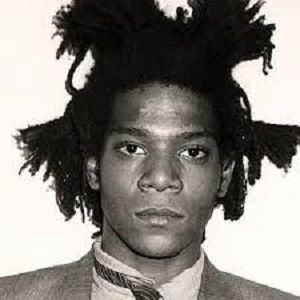Jean-Michel Basquiat (1960-1988) Jean-Michel Basquiat was born in Brooklyn, New York, in 1960. Jean-Michel Basquiat (1960-1988) displayed a talent for art in early childhood, learning to draw and paint with his mother's encouragement. Together they attended New York City museum exhibitions, and by the age of six, Jean-Michel found himself already enrolled as a Junior Member of the Brooklyn Museum. After being hit by a car as a young child, Basquiat underwent surgery for the removal of his spleen, an event that led to his reading the famous medical and artistic treatise, Gray's Anatomy (Originally published in 1858).
Basquiat's art was fundamentally rooted in the 1970s, New York City-based graffiti movement. Basquiat began exhibiting regularly with artists like Julian Schnabel and David Salle, all of whom were reacting, to one or another degree, against the recent historical dominance of Conceptualism and Minimalism. Neo-Expressionism marked the return of painting and the re-emergence of the human figure.
Jean-Michel Basquiat (1960-1988) Jean-Michel Basquiat was born in Brooklyn, New York, in 1960. Jean-Michel Basquiat (1960-1988) displayed a talent for art in early childhood, learning to draw and paint with his mother's encouragement. Together they attended New York City museum exhibitions, and by the age of six, Jean-Michel found himself already enrolled as a Junior Member of the Brooklyn Museum. After being hit by a car as a young child, Basquiat underwent surgery for the removal of his spleen, an event that led to his reading the famous medical and artistic treatise, Gray's Anatomy (Originally published in 1858).
Basquiat's art was fundamentally rooted in the 1970s, New York City-based graffiti movement. Basquiat began exhibiting regularly with artists like Julian Schnabel and David Salle, all of whom were reacting, to one or another degree, against the recent historical dominance of Conceptualism and Minimalism. Neo-Expressionism marked the return of painting and the re-emergence of the human figure.
1982 was a banner year for Basquait, as he opened six solo shows in cities worldwide and became the youngest artist ever to be included in Documenta, the international contemporary art extravaganza held every five years in Kassel, Germany. During this time, Basquiat created some 200 art works; sketchy and Neo-Expressionist in appearance, the portraits captured the essence rather than the physical likeness of their subjects. The ferocity of Basquiat's technique, those slashes of paint and dynamic dashes of line, presumably revealed his subjects' inner-self, their hidden feelings, and their deepest desires.
By the early 1980s, Basquiat had befriended Pop artist Andy Warhol, with whom he collaborated on a series of works from 1984 to 1986, such as Ten Punching Bags (Last Supper) (1985-86). At the same time, Basquiat was unfortunately becoming increasingly addicted to heroin and cocaine, which untimely led to his tragic death in 1988 at the age of 27.
A product of the hyped-up 1980s, Basquiat and his work continue to serve for many observers as a metaphor for the dangers of artistic and social excess. Like a superhero of a graphic novel, Basquiat seemed to rocket to fame and riches, and then, just as speedily, fall back to Earth, the victim of drug abuse and eventual overdose.
